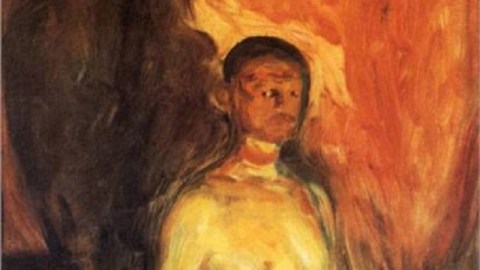Munch at 150: More to Scream About?

If you know only one work of modern art, it’s probably The Scream. More people know that “Mona Lisa” of modern angst than know the name of the artist that painted it over a century ago—Edvard Munch. From 1893 through 1910, Munch painted multiple versions of The Scream in several media, the equivalent of releasing your greatest hit on several albums. No one-hit wonder, however, Munch built a long and screamingly successful career that elevated him to the status of national hero in his native Norway. To mark the sesquicentennial of Munch’s birth this December, Oslo’s Munch Museum launched a massive Munch 150 exhibit, which is accompanied by a brilliantly fresh look in the companion catalog, Edvard Munch: 1863-1944. As much as we’d like to think we know the “real” Munch, much of that Munch belongs to the mythology that arose around the mysterious artist, and much of that Munch mystery marketing came from the man himself. From this reevaluation, Munch arises from the mists of his and others making and appears more creative and more compelling than ever.
Before hitting it big in his native Norway, Munch first hit it big in, of all places, Germany. The German Expressionists fell in love with Munch’s style, just as they earlier fell in love with the style of Vincent van Gogh. More importantly, the German Expressionists fell in love with Munch’s personal story. Just as van Gogh found posthumous fame thanks to the powerful combination of his paintings and personal story (van Gogh’s letters had recently been translated into German and his brother Theo’s widow worked the German market hard), the mentally and emotionally unstable Munch and his art arrived like the second coming of Vincent, but with the advantage of still being alive. From the very beginning of his fame, Munch recognized that his public persona as it played out in his painting held an important role in his art.
As Jon-Ove Steihaug writes in the catalog, there is a “performative character” to Munch’s paintings, especially his self-portraits. “Munch uses these portraits to stage himself,” Steihaug continues, “which in turn contributes to creating the image that the public will have of him.” When Munch paints his Self-Portrait in Hell (detail shown above), he wants you to see and feel the hell he feels his life to be. “Munch performatively places himself in situations that have innate psychological drama,” Steihaug argues, “where he alternately presents himself as melancholic, tormented, ill, distressed or driven by erotic desire.” A one-man soap opera, Munch tapped into the modern vein of existential angst and cried a river of personal drama onto his canvases. “My whole art was rooted in the contemplation of disease,” Munch reminisced in 1930. “Without fear and illness my life would have been without a rudder.” If he hadn’t of been such a mess, Munch suggests, he would never have been such an artist.
But was Munch really such a mess? Jay A. Clarke asks that very question. “[U]s[ing] biography to unpack biography,” Clarke challenges Munch’s written (and often rewritten) autobiography to question just how much of that drama turned art was real and how much was generated in the name of art. “In Munch’s case,” Clarke concludes, “the art = life trajectory was established early on and continually strengthened by hyperbole and iteration.” We all know The Scream as the quintessential image of the zenith of existential despair. What we might not know is how often that zenith was reached by Munch in his images. Munch used and reused The Scream for years, “screaming” for attention to reinforce his public image. “By visual and textual exaggeration, Munch and his biographers ensured that his physical and emotional suffering, his biography, would remain a lasting part of his story,” Clark proves. “No one, not even Munch, could have imagined how powerful and indelible this screaming legacy would be.” So, a strategy employed by Munch first hand (and by his enabling biographers and critics second hand) evolved from a contemporary aesthetic and marketing strategy to a canonical truth in the annals of art and cultural history.
Even when Munch wasn’t painting himself, he was “painting himself.” Hans-Martin Frydenberg Flaatten sees Munch’s “temperament” reflected in the landscapes of his painting, from the swirling, blood-red background of The Scream to the idea of nature as a source of renewal in the late, beautifully (and uncharacteristically for Munch) optimistic The Sun. Munch’s The Frieze of Life, which he subtitled “A poem about life, love, and death,” occupied much of his career and set up the most powerful, extended narrative of his life and work. Mai Britt Guleng, believes that The Frieze, rather than a monologue, acts as a dialogue with the viewer. “The open-ended character of Munch’s series demonstrates that they did not pretend to represent a fixed theme of purpose,” Guleng argues, “but that meaning arises in the viewing… The picture series imply more than they explain, awaken curiosity rather than satisfy.” Thus, we fall for Munch’s biographical bait and become complicit in his myth making. In addition to the great outdoors, Munch could turn even an interior into a dissertation on his psyche’s interior. (There’s an interesting comparison between Nils Ohlsen’s view of Munch and interiors and T.J. Clark’s view of Picasso and interiors in Picasso and Truth [which I reviewed here] waiting to be written.) Finally, Øystein Ustvedt sees Munch’s full-length standing portraits of prominent men as a means by which the painter himself rose in social status and became the iconic painter of Norway and, eventually, an international figure.
But Edvard Munch: 1863-1944 isn’t all about tracing the already-known paths Munch took to becoming “Munch.” In a fascinating, recontextualizing look at Munch, Ingeborg W. Owesen reevaluates Munch’s often difficult relationship with the idea of women, specifically women struggling for equality in Norway and internationally at the end of the 19th and opening of the 20th centuries. “No attempt is made to advance a theory of Munch as a feminist—nor to fend off any indications of misogyny,” Owesen writes. “The objective here is to submit a more nuanced and complex understanding of some of his pictures of women.” For all the images of women as blood-sucking vampires, Munch could also paint a work such as 1894’s The Day After, which shows a woman asleep on a bed, presumably after a night of passion, heavy drinking, or both. “Here Munch portrays [woman] as man’s equal, she too can experience euphoria, whether triggered by intoxicants or sex,” Owesen points out.
Munch’s finally mask or persona arose out of the ashes of World War II. Because Munch refused the overtures of the Nazis to assist in their propaganda during the German occupation of Norway during the war, Munch became a living embodiment of Norway’s national resistance and resolve. Between 1945 and 1963, as Øivind Storm Bjerke traces in the catalog, Munch exhibitions triumphantly circled the globe as advertisements of the artist and his homeland while the Munch Museum was being built to house Munch’s work as well as cement his position for posterity. Thus, the idea of Munch as the artist we now know him as owes as much to his personal embrace of the darker elements of his autobiography as to his refusal to turn to the dark side of the Third Reich.
I used to work with someone who kept an inflatable punching bag version of The Scream in the corner of her office. It was one of those kitschy, ironic items people love to fill their workdays with. As Edvard Munch: 1863-1944 illustrates, we’ve come to fill our days with the concept of Edvard Munch that he wanted us to have—a form of manipulation, perhaps, but also an extraordinarily early recognition of the dark corner that the course of modern existence was headed for. It’s easy to make a punching bag of Munch and his manipulativeness, but the writers of this book never take the easy shots. Instead, they see Munch as a working artist taking the ideas of his time as well as the circumstances of his life to create a compelling whole, a continuum between artist and art, that we still find fascinating. Even after a century and a half, the life of Edvard Munch is something to scream about—in anguish, but also in joy.
[Image:Edvard Munch. Self-Portrait in Hell (detail), 1903. Image source.]
[Many thanks to Rizzoli USA for providing me with a review copy of Edvard Munch: 1863-1944, edited by Mai Britt Guleng, Birgitte Sauge, and Jon-Ove Steihaug.]





